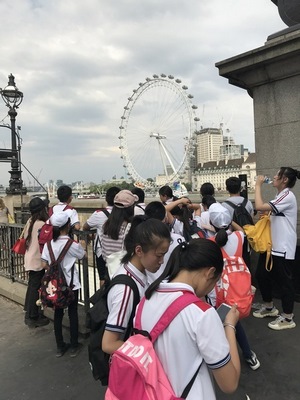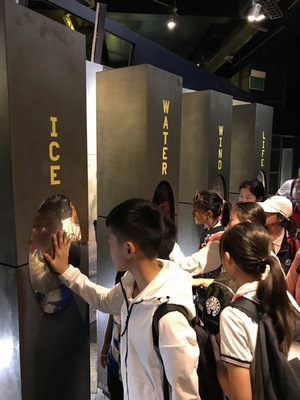在日益激烈的竞争中,美妆品牌运用的科技手段也越来越先进,从人工智能到增强现实,哪些科技潮流和产品正在重塑美妆业呢?
1. Personalisation and AI
用人工智能实现个性化定制
According to Guive Balooch, global vice president of L'Oreal's Technology Incubator, "50% of women complain that they can't find the right shade of foundation for their face, and women with darker skin tones have been crying out for more choice."
欧莱雅高新技术创业中心全球副总裁吉夫·巴洛赫说:“50%的女性抱怨找不到色调适合自己的粉底液,而肤色暗的女性希望有更多选择。”
But putting thousands of shades on shop shelves would be "impractical", he says.
他说,然而在商店货架上摆放数千种色号的粉底液是“不现实”的。
Instead, L'Oreal subsidiary Lancome has come up with a custom-made foundation machine called Le Teint Particulier, which promises to find the "exact match" for your skin using AI.
欧莱雅旗下的兰蔻推出了一种根据客户需求定制粉底液的机器,名为肤色粉底定制仪,据说能用人工智能技术来找到“精确匹配”肤色的粉底液。
Lancome's consultants first work out your facial skin tone using a handheld colorimeter - a type of digital scanner. The results are then run through a computer, which uses a proprietary algorithm to choose from 20,000 different shades. Finally, the computer's findings are sent to a machine that mixes the foundation for you, there and then in the shop.
首先,兰蔻的咨询师会用一个手持色度计(一种数字扫描仪)测出你的脸部肤色,然后把结果输入电脑,电脑会用一种专有算法在2万种色号中做出选择。最后,电脑的计算结果将发送到一台机器,机器会当场为你在店里调制粉底液。
According to market research firm Mintel, demand for personalized cosmetics is growing fast. Nearly half of consumers like the idea that a beauty product is personalized especially for them, and a third think such products give better results.
据市场调研公司英敏特透露,个性化化妆品的需求量增长迅速。近半数顾客喜欢为自己定制专属的个性化美妆产品这个想法,三分之一的顾客认为使用这种产品效果会更好。
2. Virtual 'try on' apps
虚拟“试妆”应用
As we do more of our shopping online beauty brands are increasingly using augmented reality (AR) to enhance the experience.
随着我们网购增多,美妆品牌也越来越多地使用增强现实技术来提高我们的网购体验。
Improvements in image recognition and face tracking tech is making these digital overlays more accurate.
图像识别和面部追踪技术的改进让这些技术叠加产品的结果更加准确。
Take Sephora's Virtual Artist, which lets customers virtually try on thousands of shades of lipstick and eyeshadow through their smart phones or at kiosks in stores.
以丝芙兰的“虚拟艺术家”为例,这一应用让顾客通过智能手机或商店的化妆间虚拟试用数千种颜色的口红和眼影。
kiosk['kiɑsk]: 亭子
The app works by measuring where your lips and eyes are in real time, then tracking those facial feature points so it knows where to put the cosmetics.
通过实时测量你的嘴唇和眼睛的位置,这款应用追踪这些面部特征的点,从而得知在哪里上妆。
Sephora says more than 200 million shades have been tried on through Virtual Artist since it was launched in 2016, and a host of other brands, from Garnier to Germany's DM, have launched "try on" apps, too.
丝芙兰表示,自从2016年推出“虚拟艺术家”后,眼影和口红已经被试用2亿多次。包括卡尼尔和德国DM在内的多个品牌也已经推出了试妆应用。
But some reviewers warn the apps are no substitute for trying on products for real before you buy them.
不过,一些评论人士警告称,在决定是否购买时,试妆应用不能替代亲自试妆。
Maghan McDowell, innovation editor at Vogue Business, agrees they are not "100% accurate" but says customers still find them useful.
《Vogue Business》的创意编辑梅根·麦克道威尔承认这些应用的结果不是百分百准确,但顾客仍会感觉有用。
3. Smart skincare tools
智能护肤工具
Would you trust a computer to rate your skin? The HiMirror, a "smart mirror" made by Taiwan's New Kinpo Group, does just this.
你信任一台电脑来评价你的肤质吗?台湾新金宝集团制造的智能镜子HiMirror就能实现这个功能。
It takes a photo of your face every time you log in and scans it for wrinkles, red spots, pores, fine lines, and brightness levels.
每次你登录时HiMirror都会给你拍一张照片,扫描你的皱纹、红斑、毛孔、细纹和亮度。

新年伊始,听说有好多同学声称自己去年的读书li...

不知是不是因为今年疫情的缘故,总觉得时间过得...

2020年即将过去,本年度的【好书荐读】系列也迎...
